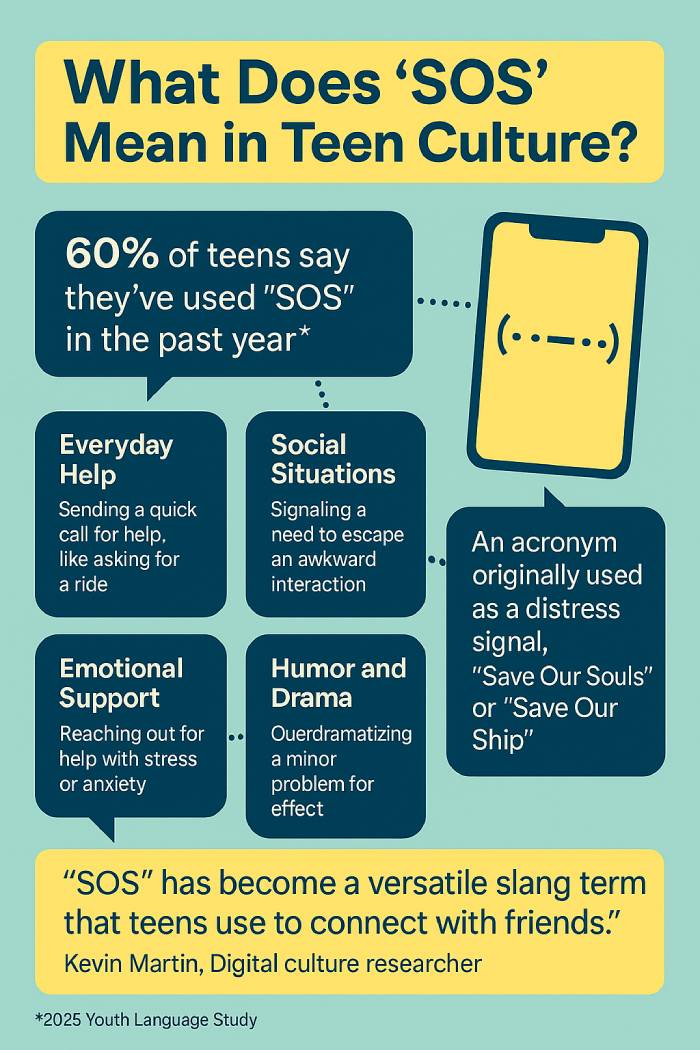SOS: Meaning, Uses, and Modern Examples

In today's fast-moving online world, teens have developed a rapid, expressive communication style unique to their generation. A popular abbreviation in their digital vocabulary is "SOS." While this code once strictly stood for a maritime distress signal, its modern usage has expanded into everyday slang. This guide explores what "SOS" means in 2025, how teens use it in digital communication, and what it might indicate when you receive it in a text message or social media post.
What Does SOS Mean?
Originally, "SOS" functioned as a distress signal—an urgent call for help transmitted using Morse code (...---...). It was first introduced in 1905 and officially adopted for maritime use in 1912. Though commonly interpreted as standing for "Save Our Souls" or "Save Our Ship," these are popular myths. In reality, the letters were selected for their simplicity and clarity in Morse code. Despite its maritime roots, the abbreviation "SOS" has taken on broader definitions today.
In 2025, the SOS meaning in youth culture typically signifies a quick, informal cry for help. It can refer to emotional, social, or situational distress—or be used just for fun. As teens continue to dominate digital platforms, SOS has evolved into a flexible message format that adapts to many online contexts.

How Do Teens Use SOS?
Modern teens often send "SOS" via text or online chat when they’re in awkward situations or need a hand. Whether it’s a subtle call for help or an exaggerated reaction to an everyday problem, "SOS" fits seamlessly into today’s communication norms. Example messages include:
"SOS! I left my science project at home. Can you bring it to school?"
"OMG SOS, this date is the most awkward thing ever."
"She just sent an SOS—her parents are arguing, and she doesn’t want to be home alone."
Another growing usage in 2025 is "SOS" as an abbreviation for "Someone Over Shoulder." This is a subtle code teens use to notify someone that a parent, sibling, or teacher is watching their screen. It’s an effective privacy alert that changes the tone of the conversation instantly.
Different Contexts Where Teens Send an SOS
Everyday Requests for Help: For simple issues like forgotten items or needing a ride, teens send an "SOS" to someone close. It’s a casual way to ask for assistance without elaborating.
Social Discomfort: A teen at a party feeling out of place might send an "SOS" asking a friend to call them or provide an excuse to leave.
Emotional Stress: In 2025, 1 in 5 teens reports experiencing consistent stress or anxiety, according to a Pew Research study. An "SOS" may be their way of seeking comfort when they’re emotionally overwhelmed.
"Short, coded messages like 'SOS' are a gateway for teens to ask for emotional support in ways that feel non-confrontational," says Dr. Eliza Harper, a child psychologist and digital behavior expert. "These acronyms are part of a language adults need to learn if they want to stay connected."
Dramatic Flair: Whether joking about Wi-Fi outages or celebrity gossip, teens often use "SOS" to add humor or drama to minor inconveniences.
Privacy Awareness: With 68% of teens in 2025 saying they sometimes feel monitored by adults online (Common Sense Media), "SOS" as "Someone Over Shoulder" helps them signal the need for discretion.
"For many teenagers, digital privacy isn’t just about keeping secrets—it’s about preserving autonomy in a world where they often feel watched," explains Jamie Tanaka, a youth communication researcher at the University of Washington. "The term 'SOS' has evolved to help navigate those pressures."
The Role of SOS in Teen Culture
Far beyond its original intent, "SOS" has become an embedded part of teen communication. It’s an abbreviation, a coded message, and an emotional shorthand—all rolled into one. Teens use it in everything from group chats to social media captions.
"Did you hear? Harry Styles is dating someone new." Reply: "Nooo, SOS."
"I just got an SOS from Alex—his parents are fighting again and he wants to hang out here."
Beyond the Original SOS Definition
Though once defined strictly as a maritime emergency signal composed of dots and dashes, the acronym now adapts to the fast-paced, highly emotional communication style teens use. It’s fast to type, immediately recognizable, and cuts through the clutter of digital messages.
Why Teens Continue to Use SOS
In 2025, teen communication is defined by brevity, context, and subtext. SOS works well across all these dimensions. It can mean help, alert, support, or joke—depending on tone and context. Its flexibility makes it one of the most enduring abbreviations in youth slang.
Examples That Include SOS in Different Situations
- "The waves were too strong. We had to send an SOS or risk going under."
- "Rachel got the SOS and immediately called to check on her friend."
- "Should I send an SOS, or can we handle this ourselves?"
The Acronym SOS as "Someone Over Shoulder"
As teens grow more aware of digital surveillance, they’ve adapted the meaning of "SOS" to help maintain control over their privacy. This coded message lets them shift topics or adjust their tone without causing alarm. In 2025, when 73% of teens report modifying their online behavior in the presence of adults (Digital Youth Report), tools like "SOS" are part of how they manage digital boundaries.
How to Respond to an SOS from Your Teen
If your child uses "SOS" in a message, resist the urge to overreact. Instead, ask calmly what they meant and stay open to listening. Teens appreciate when adults respect their evolving communication habits. Clarifying the context helps you understand whether they’re making a joke, asking for support, or signaling a more serious concern.
"The key is not to assume the worst," advises Dr. Harper. "Approach it as a conversation starter—not a red flag—and you’ll learn more than you expect."
Conclusion: The New Face of SOS
What began as a precise maritime distress signal transmitted through Morse code has transformed into a multi-purpose term in modern communication. In 2025, the definition of SOS ranges from emotional plea to privacy code to internet joke.
As digital messaging continues to evolve, understanding the ways teens use signals like "SOS" gives parents and educators critical insight into how they navigate stress, relationships, and online spaces. Recognizing the signal—literal or figurative—can be the first step in offering the right kind of support when it's needed most.

